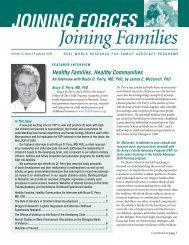stigma and barriers to care - Uniformed Services University of the ...
stigma and barriers to care - Uniformed Services University of the ...
stigma and barriers to care - Uniformed Services University of the ...
You also want an ePaper? Increase the reach of your titles
YUMPU automatically turns print PDFs into web optimized ePapers that Google loves.
Mitigating Stigma <strong>and</strong> Barriers <strong>to</strong> Care 73<br />
deliver that <strong>care</strong> is very foreign <strong>to</strong> most people. We had <strong>to</strong> learn how <strong>to</strong> have respect<br />
for spirituality, which was trained out <strong>of</strong> me 40 years ago. “Do not talk about religion<br />
or politics.” Well, religion <strong>and</strong> politics are an important part <strong>of</strong> people’s lives.<br />
We just have <strong>to</strong> figure out how <strong>to</strong> do that <strong>and</strong> do it in a respectful way. Those are<br />
some <strong>of</strong> <strong>the</strong> lenses through which I make my remarks <strong>to</strong>day.<br />
I saw <strong>the</strong> Glenn Close PSA that Pat Corrigan talked about. It was sent <strong>to</strong> us<br />
by <strong>the</strong> group that produced it. When <strong>the</strong>y sent it <strong>to</strong> us <strong>the</strong>y also sent some trailers.<br />
They were not shown publicly, but <strong>the</strong>y were interviews with <strong>the</strong> participants. They<br />
were <strong>the</strong> most powerful images that you could ever imagine, showing <strong>the</strong> compassion<br />
<strong>and</strong> <strong>the</strong> manner in which <strong>the</strong>se families worked things out in such a natural<br />
way. If you want <strong>to</strong> really go after <strong>stigma</strong> you have got <strong>to</strong> make it real for people.<br />
Most people know somebody with a mental illness, are living with someone with a<br />
mental illness, or have a mental illness. If we could get those natural moments out<br />
<strong>to</strong> people, it would have a substantial effect.<br />
Somebody who entered <strong>the</strong>ir pr<strong>of</strong>essional <strong>care</strong>er as an Army medic at <strong>the</strong> end<br />
<strong>of</strong> <strong>the</strong> Vietnam War when we were receiving veterans home can tell you it is vastly<br />
different now than it was <strong>the</strong>n, <strong>and</strong> in a good way. We did not do a good job <strong>of</strong><br />
receiving those people home <strong>and</strong> we are still experiencing some <strong>of</strong> <strong>the</strong> effects <strong>of</strong><br />
that. I cannot imagine that this type <strong>of</strong> meeting would have been held in 1971. I<br />
applaud <strong>the</strong> efforts <strong>of</strong> those who have tried <strong>to</strong> make a difference by moving <strong>the</strong>se<br />
issues out in<strong>to</strong> <strong>the</strong> sunlight so that we can underst<strong>and</strong> <strong>the</strong>m better <strong>and</strong> serve <strong>the</strong>se<br />
people better on <strong>the</strong>ir arrival home.<br />
People are empowered as a group, not just as individuals, in <strong>the</strong> military environment,<br />
which once again speaks <strong>to</strong> culture. One <strong>of</strong> <strong>the</strong> overarching <strong>the</strong>mes in any form<br />
<strong>of</strong> real, legitimate social change is <strong>the</strong> vital role <strong>of</strong> leadership. We have learned some<br />
o<strong>the</strong>r things in terms <strong>of</strong> mitigating <strong>stigma</strong> in <strong>the</strong> military. Soldiers who rate <strong>the</strong>ir<br />
leaders more highly <strong>and</strong> report higher unit cohesion are also reported <strong>to</strong> have lower<br />
scores on both <strong>stigma</strong> <strong>and</strong> perceived <strong>barriers</strong> <strong>to</strong> <strong>care</strong>. Positive leadership <strong>and</strong> unit<br />
cohesion can reduce perceptions <strong>of</strong> <strong>stigma</strong> <strong>and</strong> <strong>barriers</strong> <strong>to</strong> <strong>care</strong> even after accounting<br />
for <strong>the</strong> relationship between mental health symp<strong>to</strong>ms <strong>and</strong> outcomes.<br />
One <strong>of</strong> <strong>the</strong> areas that I think has unique challenges <strong>to</strong> <strong>the</strong> military, <strong>and</strong> maybe<br />
you could add police <strong>and</strong> firefighters <strong>to</strong> that, is <strong>the</strong> <strong>care</strong>er repercussions <strong>of</strong> seeking<br />
<strong>care</strong>, which Sue Estr<strong>of</strong>f brought up earlier. Everybody recognizes it but I am not<br />
sure we operationalize it. What does it mean There is this <strong>care</strong>er kiss <strong>of</strong> death for<br />
those who seek help. Is it a one-time opportunity <strong>and</strong> you can ei<strong>the</strong>r never get rid<br />
<strong>of</strong> it or you can go on <strong>to</strong> serve When I was still working in <strong>the</strong> government we had<br />
a big fight with <strong>the</strong> Central Intelligence Agency (CIA) over security clearances <strong>and</strong><br />
people who had sought mental health <strong>care</strong>, even people who had been successfully<br />
treated. We did not win that fight back <strong>the</strong>n.<br />
An area <strong>of</strong> consideration when addressing <strong>stigma</strong> in military populations <strong>and</strong><br />
first responders is <strong>the</strong> public policy angle. Both <strong>of</strong> <strong>the</strong> previous speakers talked<br />
about this as well. Recently, after decades <strong>of</strong> struggle, we have ended one <strong>of</strong> <strong>the</strong><br />
most obvious structural forms <strong>of</strong> <strong>stigma</strong>, which was <strong>the</strong> lack <strong>of</strong> insurance parity<br />
for <strong>the</strong> treatment <strong>of</strong> mental illnesses. Why did that fight go on for so long when <strong>the</strong><br />
information showed that not only was it <strong>the</strong> right thing <strong>to</strong> do but it was <strong>the</strong> smart<br />
thing <strong>to</strong> do It was a cost-effective thing <strong>to</strong> do.<br />
Ano<strong>the</strong>r sensitive area is illustrated by <strong>the</strong> example <strong>of</strong> a veteran, a former<br />
Marine, who had suffered tremendous physical injuries but who had a hard time<br />
reconciling <strong>the</strong> fact that he also had PTSD. That raises a very troubling question. We




